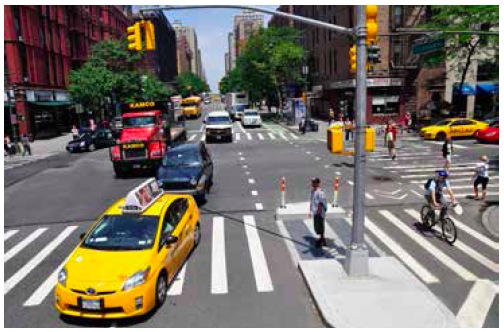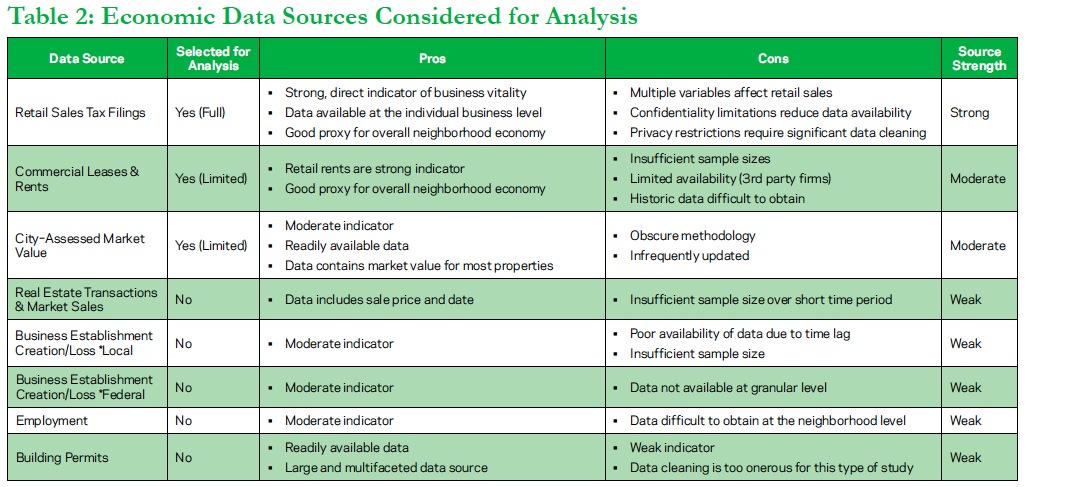NEW YORK CITY DEPARTMENT OF TRANSPORTATION
Solving urban challenges has become the key to addressing global challenges. New York City has been a leader in creating new models for sustainable urban development in recent years, most visibly with the transformation of the city’s streets into more efficient and welcoming spaces that better accommodate all users. In tandem with these planning and engineering efforts, the New York City Department of Transportation (DOT) has developed a robust set of metrics to evaluate the outcomes of its projects with respect to the agency’s policy goals, both in the service of continually improving project designs and because the public increasingly expects such data-driven decision-making from government.
These goals – including safety, access and mobility, environmental health and economic vitality – have been well documented in publications such as Sustainable Streets, Measuring the Street and the New York City Street Design Manual, and a trove of the resulting data has been published in reports including the annual Sustainable Streets Index. While DOT makes regular use of metrics on safety and mobility – the more traditional focus for measures of urban streets – the agency has only recently added data on local economic impacts to its set of standard project metrics.
Despite the critical importance of making the connection between transportation policy and economic health in light of ongoing economic and budgetary challenges, a review of current practices found no well-established, objective methodologies for evaluating the impact of street design improvements on neighborhood economies. Therefore, DOT set out to develop a new metric. Working with its consultant, DOT evaluated a number of potential measures of local economic vitality and found retail sales – specifically reported sales for street-level retail and restaurant/ food service businesses – to provide the most direct and reliable indicator of the health of local businesses.
Through an iterative process with the New York City Department of Finance (DOF) – who receives New York City sales tax data from New York State, analyzes it and aggregates all results to preserve taxpayer privacy– the study team developed, tested and refined a consistent and replicable approach for analyzing sales tax data. Filters were applied to limit tax data to only relevant businesses in terms of industry category and physical storefront location; due to the nature of the tax returns, businesses included in the analysis tend to be locally-based “mom-and-pop stores” and independently operated franchises. Study areas were defined for the street improvement projects as well as for several comparison sites. The change in sales for locally-based businesses within the improvement sites before and after project implementation was compared to changes in the same period for the comparison sites as well as the respective borough as a whole. This methodology was applied to a range of projects including pedestrian plazas, bike paths, intersection redesigns and bus rapid transit.
These results provide convincing evidence that improved accessibility and a more welcoming street environment created by these projects generate increases in retail sales in the project areas. This does not mean that all projects will show economic benefits, just as not all projects improve the operations of a particular mode or improve all measures of safety. However, it is now possible to document the impacts of changes in street design on surrounding locally-owned retail businesses in a rigorous and compelling way, expanding the range of metrics that government agencies as well as communities have available to measure the effects of these projects.
Data on retail sales can now be used to help address the concerns of local residents and business owners about potential project impacts, replacing anecdote or personal experience with comprehensive data, and potentially activating the business community in support of appropriately designed projects. These kinds of empirical results can also allow cities to link street design more closely with economic development goals, just as cities are beginning to link street design with public health and environmental goals. Importantly, New York City’s analysis shows that 21st-century streets can contribute to the economic vitality of neighborhoods across the full spectrum of income levels and geography, from major destination shopping districts to neighborhood main streets.
Download full version (PDF): The Economic Benefits of Sustainable Streets
About the New York City Department of Transportation
nyc.gov/dot
“DOT’s mission is to provide for the safe, efficient, and environmentally responsible movement of people and goods in the City of New York and to maintain and enhance the transportation infrastructure crucial to the economic vitality and quality of life of our primary customers, City residents. Our agency’s work is guided by Sustainable Streets, the Strategic Plan for the New York City Department of Transportation. We are customer-driven in all our activities. We seek opportunities to create partnerships in the provision of transportation services through appropriate relationships and alliances.”
Tags: Complete Streets, New York, New York City, New York City Department of Transportation, NY, NYC, NYC DOT, Pedestrian








 RSS Feed
RSS Feed